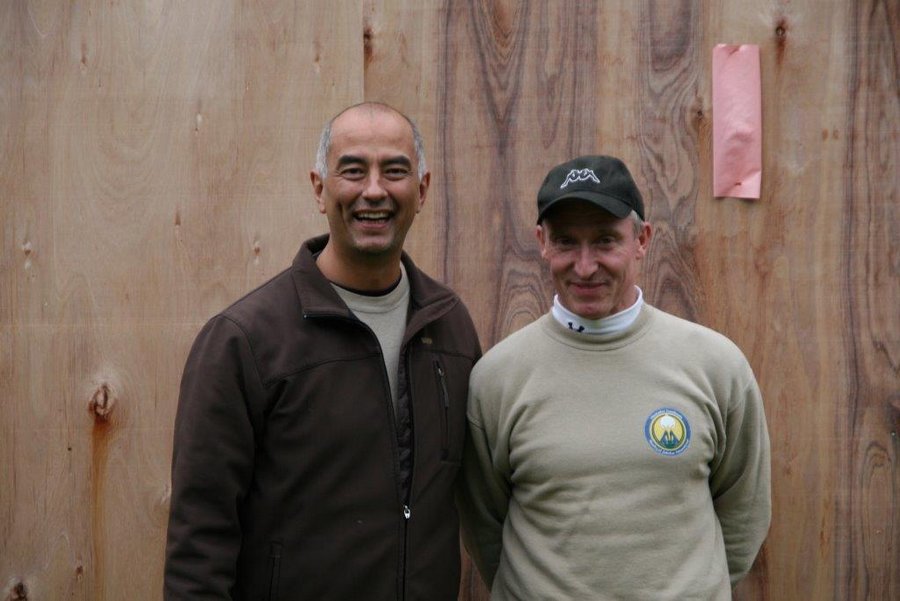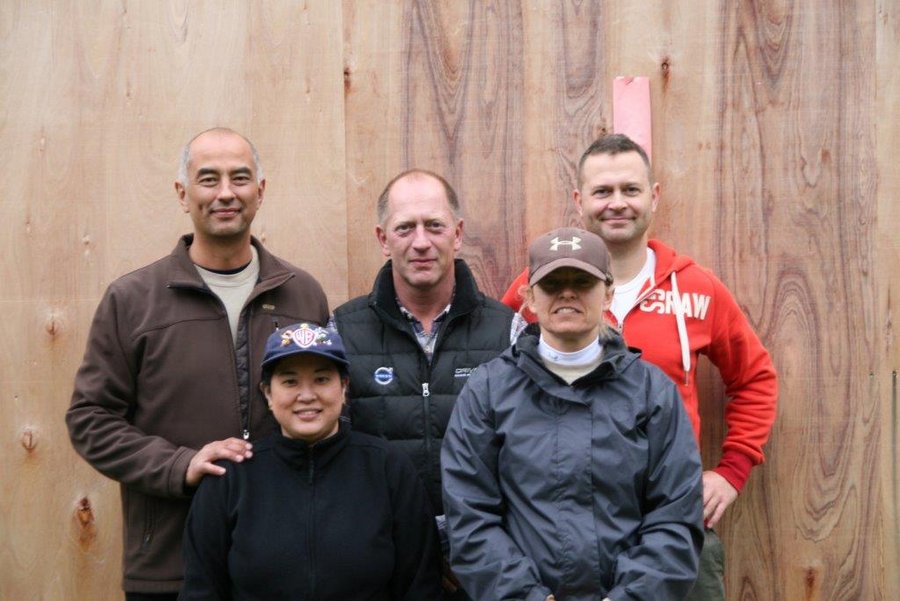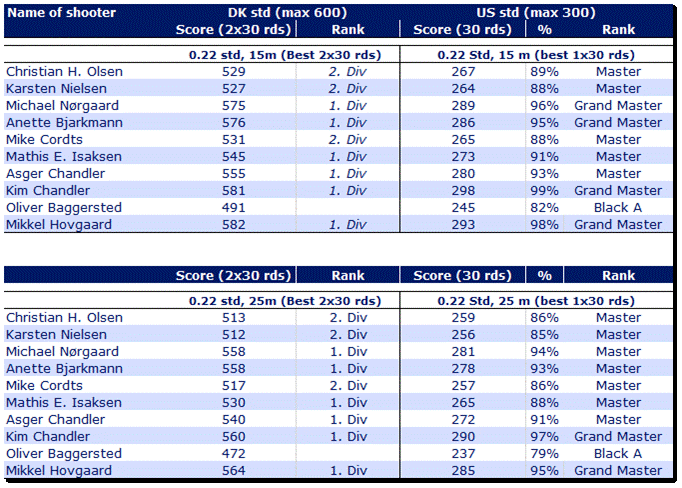
By Martin E. Hansen, Member until 2018
The dust has once again settled over Hanebjerg near Hillerød in North Zealand. The POMW pistol project has reached its end and only Kimu Sensei continues the uncompromising path towards the complete POMW shooter. For everyone else, this means that POMW pistol and the just completed POMW 3 is a competency on equal terms with other KYU competencies in Yakami Shinsei-ryu. However, there is a marked difference to Yakami Shinsei-ryu's other skills – shooting is actually simple and rewarding. There will probably be many who do not agree, but basically shooting is about aiming, pressing the button and then hitting - more or less accurately. This is the case at short distances ie. out to approx. 3-500 m, where mother nature also suddenly gets a role and where quite a few also practice general shooting. POMW 3 is the transition from range shooting to terrain/IPSC shooting, i.e. practical shooting. For the participants, this meant that the shooting now moved from the semi-indoor range and precision shooting to outdoor and area shooting. The question was then whether the participants, similar to Kimu Sensei and later the chief instructors, could get as remarkable results as during POMW 2. Did Minouchi Sensei's theory and thus Kimu Sensei's argument for the difference between martial arts and martial arts, and was Kimu Sensei's POMW shooting technique bulletproof 🙂 even without for the range shooting? – can a Yakami Shinsei-ryu martial arts student with the right attitude learn the metiers of the modern warrior in an ultra short time?
As you know, POMW 2 showed sky-rocketing results that resonated over most of the shooting world both in DK, but also abroad. Foreign countries in particular have followed the POMW project with great interest – the American defense has attempted a similar project in the million USD class, which, however, never brought equally significant results. For some, it is provocative that an outsider with no shooting experience in an ultra-short time finds the essence of shooting, can shoot against or equal to the elite civilian as well as military, and can even learn it from him in an optimal way. For others, it's just a welcome gift and a golden opportunity for which they would give half the kingdom 😉
As with everything else in this world, those who possess a top skill, and have spent a long time acquiring it, also want to protect it, make it special, complicate it and wrap it up in other good things. Why? It is human nature when it is controlled by an ego that wants to make its owner special and unique. As written in previous articles, it was also jante law, big egos, own interpretations of the law and rabid attitudes that first met Kimu Sensei and later the chief instructors during the POMW start-up in the Danish shooting associations. All of this was spared the subsequent participants, as Shindenkan now has its own open member shooting association, with shooting instructors and shooting leaders both fully trained and also in training. Of course shooting instructors with between 15-35 years of teaching experience from tens of thousands of students nationally and internationally. In this way, the students in Shindenkan can concentrate on the essence of shooting on equal terms with the other multi-track skills at KYU level in Shindenkan, and under the same learning principles and values, but most of all without the influence of big egos, inferiority complex and jantelaw!
POMW 3, also called "POMW PI - POMW Pistol Intermediate", is the natural superstructure of POMW 2 following the common thread designed and developed by Kimu Sensei. Like the other courses, it is designed as a module course and in this case 3 modules. The first module was held on Sunday 1 September, the 2nd module on 8 September and finally the 3rd module on 22 September. The last two modules served simultaneously as shooting leader training for the two shooting instructors Jens Hanshi-dai and Martin Renshi. In contrast to the other POMW courses, the participants on this course would experience pure outdoor shooting with all that this entails such as weather, lack of stationary aids, range conditions etc.
A sunny Sunday morning at At 8.30 the participants then met up for the first module of the POMW 3 course. Leading up to the course, they had all been told that it was important to dry train every day as well as strength train with dumbbells in the POMW shooting technique position, so that they could continue the trend from POMW 2 and not have to start more or less from the beginning.
POMW 3 would be tough as the participants could expect to fire at least 1200 9mm rounds and approx. half in caliber 0.22. Those who showed up early helped to get the track finished, which consisted of six set up goals, each of which consisted of 2 rafters with IPSC discs in between, where a track disc was stuck on. In this way, the participants were accustomed to the IPSC slices through something they had been used to.
The biggest difference for the participants was the safety procedures, which were different from indoor DGI / DSkyU (DGI before DDS and DIF – Danish Shooting Union) shooting and for the outdoor DSF (DIF – DSkyU – Danish Sports Shooting Federation) shooting. All commands in connection with loading, shooting and unloading were now in English instead of the Danish ones used in the shooting house for indoor shooting. However, they had become acquainted with them during POMW 1, among other things. by IPSC airgun. It was then also the international commands from the IPSC that were used.
But before the shooting could even start, the most important thing was that security was in place. The range instructions had been read by participants and Kimu Sensei, as overall shooting leader and trained DIF DSkyU DSF IPSC Range Officer (IROA 1), could begin to explain the rules. First of all, it was important to behave correctly on the shooting range with weapons and ammunition and, of course, to have control of your own safety equipment in the form of shooting glasses and hearing protection. In terms of safety, a safety table was set up where all gun handling took place, i.e. the gun was inspected, loading grips etc. could be practiced towards the rampart. Next, a separate loading table was set up, where all ammunition and magazine handling took place. Since there were 10 participants in addition to the chief instructors who were also on the course, there were 3 teams with 5 people each, i.e. there was always a shooter (in the hole) who could pretend to be the one who was shooting (Shooter) or himself and the chief instructor they had assigned as shooting/safety instructor.
After the safety briefing and team division, it was time for dry training, which was also a safety moment. It had been a while since the participants, apart from the chief instructors, had held a 9mm in their hand, so there was naturally a bit of nervousness to be seen. Kimu Sensei had designed a series of dry training exercises where the participants were allowed to handle the gun and go through loading, shooting and unloading procedures according to POMW shooting technique and correct POMW Tai-sabaki 🙂
Throughout POMW, Kimu Sensei has made comparisons to martial arts, and of course this also applies to the basic handling of the weapon itself. It was clear to see who had practiced at home with the toy guns and who hadn't practiced as much, which Kimu Sensei also took into account in the team division. After the gun handling had been reviewed, the handling of the gun change and the rotation of shooters, handing out and checking of ammunition followed, so that the rest of the day could proceed at a nice pace, since there were many shots to be fired.
The first shooting task was to shoot the gun in and find your aiming point with the exact gun you had available, nicely lent by the chief instructors, as SDKskyt does not yet own 9 mm association pistols. At the same time, it was important that the participants got used to standing in the open, where you suddenly have wind in your hair, the sun in your eyes or rain in your face, and a rain of casings from the shooter next to you.
The first few shootings also gave the participants time to rehearse POMW shooting technique, where every shot counts. Kimu Sensei went from participant to participant and corrected the immediate mistakes so that they could be improved for the next shooting. As mentioned earlier, point discs were pasted on IPSC targets, so that the participants could get used to IPSC targets based on something they knew and go from point shooting to area shooting, i.e. instead of 10s, 9s, etc., it became alpha, charlie and delta zones.
The shooting actually went really well and Kimu Sensei was impressed by how well the shooters did. It went really well at short range (7m), so Kimu Sensei used the next shots to increase the distance to 10, 12 and 25m. It was important for the shooters to find out that the further away, the more time you have to spend on getting the correct aiming image or as Kimu Sensei says "You have to hurry with everything else except the actual shooting moment". As module 1 drew to a close, Kimu Sensei was still very satisfied and the pace had been satisfactory and the discs spoke their own language, it was approx. 75-90% in alpha spread over the entire field.
Kimu ended the day by praising the participants for the attitude and the focus they had had during the shooting and in between and was sure that they should probably be able to feel the body the next day 🙂 After all, they had shot about 450 9mm shots, which according to DGI/DDS examinations correspond to several years of shooting for the average Danish shooter. At the same time, the participants were also tasked with going home and dry training every day and trying to stay in "shooting the clock" so that the setting and focusing could continue to module 2. Here he also advertised that there would be transition shooting and reset, which is more advanced shooting .
The weather was again nice and sunny when the participants met for the second module of POMW 3. During this module, Martin Renshi also had to act as shooting leader when Kimu Sensei was not and Jens Hanshi-dai then had to take over on the last module. In this way, the courses in Shindenkan also serve as leadership training for those who come next in line. The course was again built in the "hole" at Hanebjerg, but with 2 discs placed above and below each other for each goal. The first part of this module was to take place in the hole, after which the rest of the day after lunch was to be spent on the gun range, where POMW 2 range shooting was again to be practiced. First of all, gun handling and safety were rehearsed before the first shots could be fired at 09.00. From here on, training was started at increasingly greater distances, but this time without the scoring disc and the IPSC disc stuck on, so it was now a pure IPSC goal. The shooters still shot very well and it was clear to see that they had become more familiar with the 9mm and everyone "rested" more in their shooting and thus also became more accurate in their area shooting and there was a very high alpha percentage.
Kimu Sensei continued with the transition shooting. This was of course only trained at a short distance, where the transition (change) between the goals is greatest, and therefore makes the most sense. The participants had previously tried this with airguns and plastic bullets as well as SIRT Laser guns, but not with 9mm. But since they had trained well in the intervening period, it actually went really well.
There were, of course, corrections to be made, which Kimu Sensei identified with each shooter. The difficult challenge in transition shooting is to find the sight picture after you have moved the gun to the new target, while the recoil also presents challenges, which you can use to find the sight picture if you time it right. Normally you have a favorite page ie. that you are better at changing targets either to the right or to the left, which most of the participants also experienced.
The next challenge for the shooters was transition shooting both vertically and vertically, i.e. that one had to shoot first at the bottom of a target, then at the top, immediately after that transition to either the right or left and finally the target at the bottom, i.e. a total of four targets. During the entire process, it is important to maintain a constant flow, i.e. the time between each shot must be the same whether you move the target up or to the side. If you only heard the sound, you wouldn't be able to hear the difference between whether all 4 shots were intended for one goal or 4 different goals. Precisely this time between the shots on the targets is called the split time, which should preferably be constant. To make this split time as short as possible, which allows you to shoot faster and still be accurate, you can train "reset".
Reset has previously been described in other articles, but in short it means using the gun's mechanical construction around the trigger. Approx. 1/4 of the trigger has a clearance when the gun cock is cocked ie. reset only works with single action. This clearance can be "pulled off" before you have taken aim and fired the next shot, thereby eliminating wasted time.
Kimu Sensei demonstrated the reset for the participants and as he said "I'm a bit rusty as I concentrate mostly on POMW long range" - after which he fired 6 fairly accurate shots within 2 seconds even as transitions at 15 m. Later he did the same with a full magazine with 22 shots on 4 targets in 4-5 seconds, all in alpha, same split time and very harmonious, which made some old experienced competition shooters from another shooting association gape and say it was the fastest emptied and most accurate magazine, they have ever seen in their life including Hollywood movies and whether Kimu Sensei was a professional international top director!. Kimu Sensei didn't answer, but just politely and modestly smiled back. But it's also not the first time that very experienced competition shooters at home and abroad have said similar things about Kimu Sensei's POMW course demonstration shootings - we've all witnessed that several times 🙂 And the first time he made himself internationally noticed was just after 10 months of POMW shooting. Read The Great One – Day of Steel. After this, things went really strong in all shooting disciplines on the international scene with the "real tough boys and girls", and as Kimu Sensei likes it "Being is more important than seeming".
The shooters themselves were allowed, as the last thing in the "hole" that day, to attempt a reset. Most were successful, but there were also several who had some challenges with the fine motor skills that training "reset" requires, as you must not let go of the trigger along the way and must feel the small click in the trigger which spreads to the yolk in the index finger when it is there. But fine technique is just yummy for a Yakami Shinsei-ryu martial arts practitioner.
After collecting casings, it was off to the gunnery and the pistol range, where after a short lunch, accuracy in range shooting had to be trained again. It was also here that Martin Renshi took over as shooting director after an honorable effort in the hole as assistant shooting director. After lunch, while the shooting house was being prepared, Jens Hanshi-dai and Martin Renshi went through a so-called "field strip" and cleaning of a CZ 9mm pistol, where the participants themselves were allowed to participate in cleaning the barrel, rail etc. which took about 20 min. Subsequently, it was time for the precision shooting which took place according to the POMW 2 standard and thus back to DSKU rules and Danish commands. Martin Renshi didn't have full control of the planning, but the shooting was started belatedly. It was a rather difficult adjustment process for most, because now they had to go from range shooting and IPSC targets to precision shooting and points. People were really tired, which is why the day also ended a little earlier than expected and without 0.22 shooting. But there was plenty to practice for next time, not least for the shooting leader Martin Renshi, who received constructive feedback, which concluded that several places needed to be corrected, so that the course could run more smoothly and people could therefore concentrate 100 % on the optimality of their shooting and continued development.
The third and last module was also the exam for POMW 3. Like the other 2 modules, the participants showed up early on Sunday morning and were briefed in advance by the new shooting leader during exam training, Jens Hanshi-dai, to come extra early so that they could help prepare the track etc.
Therefore, Kimu Sensei could also start the last module at precisely 08.45 with dry training, where the entire safety procedure was again reviewed with loading, shooting, unloading, etc. Then it was picked up where the last module left off, i.e. reset training. So first shots were fired at different distances on the IPSC targets with reset including several shots per series up to 5 shots. After this, transitions were trained, also with reset, with the aim of hitting the same split time between each shot. It was clear to see that the sessions had become closer compared to module 2, especially people had become better at transitions and giving themselves better time as the distance to the discs increased. In addition, the participants had become accustomed to shooting in the open and Kimu Sensei had cured everyone of their possible fear of recoil, allowing them to relax more and rest in their shooting.
In fact, it went so well that Kimu Sensei decided that the participants should also be allowed to try their hand at shooting around barricades, as the time in the hole had been extended at the same time by agreement with those who were to shoot afterwards. For this, two barricades in the form of wooden doors in transportable frames were quickly brought into the shooting area and placed in front of some of the targets. First, the participants were allowed to dry train. As you are not allowed to draw from a holster or move while shooting, the participants had to get into position behind the barricade, lean to the side and then raise the gun from a 45 degree angle before they could fire. So it was as close to IPSC and pure practical shooting as you could get without being IPSC, because you can only do that with an A license, at least in Denmark, which is the only country in the world. After all the participants had practiced the dry training, they were then allowed to shoot around the barricade under supervision and security cover from Kimu Sensei, which went really well, as if the participants had not ordered anything else.
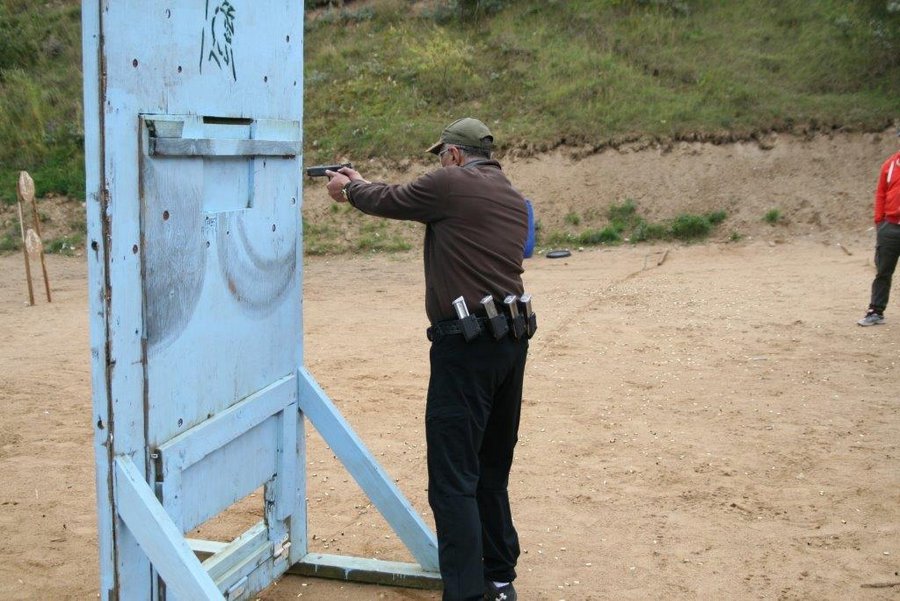
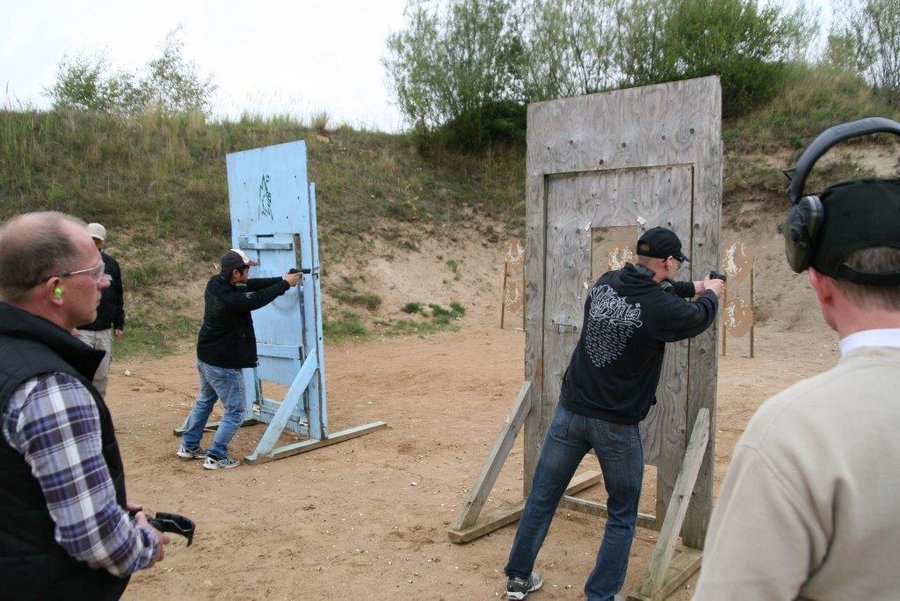

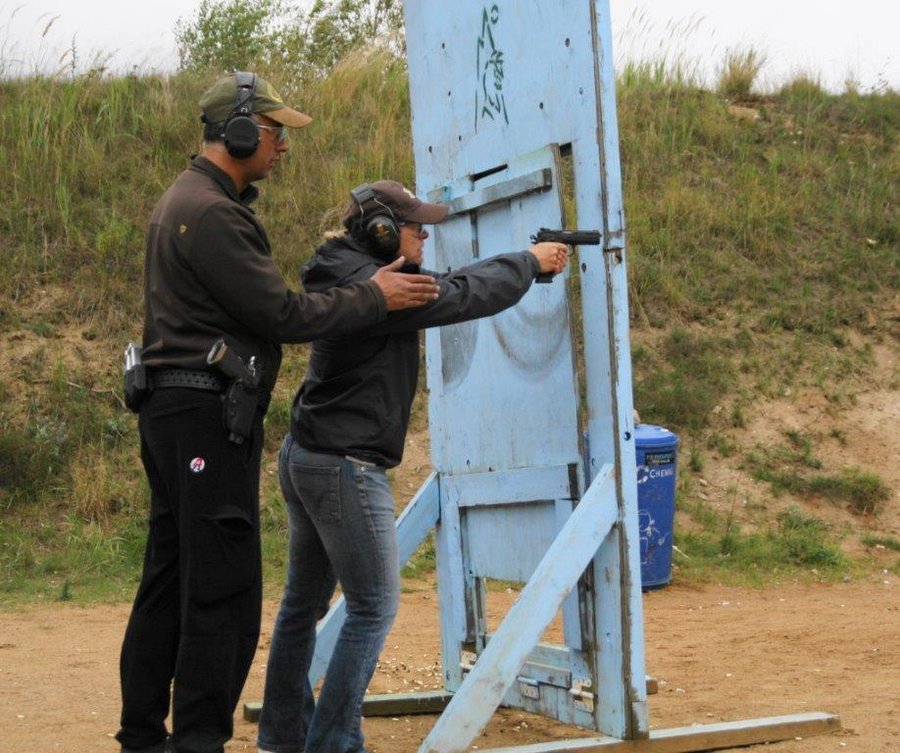
Lastly, Kimu Sensei would like the participants to understand that you can actually shoot pretty far with a gun. For this purpose, 3 metal measures (10 cm and 15 cm measures) were set up in the farthest corner of the "hole", which corresponds to approx. 50 m. Here the participants were then allowed three at a time to use their last 9mm ammunition, with the result that the nice yellow metal targets quickly turned steel gray again. You can therefore hit from a long distance with a pistol, as long as the technique is correct. It may well be that it was only approx. 80-90% of the shots that hit, but it is now also quite nice during a rapid-fire competitive match 🙂
It was time for lunch, which was taken quickly in and around the gunnery that was to form the framework for the end of POMW 3. Jens Hanshi-dai really put himself to the test as a gunner during the exam, and everything ran like clockwork and planned to the last minute, so that was a huge difference from module 2, which the participants also expressed later in their feedback. The question was simply whether the participants could change this time from area shooting in the "hole" to precision shooting on the shooting range and whether the many good shots with split, transition and reset together with POMW shooting technique and the right focus and setting could produce results. You have to say that!
In the table below you can see the difference from POMW 2 to POMW 3. POMW 3 has produced very good results and there is a difference between POMW fundamental and Intermediate shooters. POMW 3 has given far greater routine, better precision but also of course higher speed.
All results in the table below are started and finished in 3-5 minutes, which is very fast compared to what traditional shooting prescribes. But here POMW says that it is the results, the yield and the competence in a holistic perspective that count.
After all, the POMW 3 training was also what actually made two of the chief instructors for their DSkyU DSF A-license exam become No. 1 and 2 among shooters who had been shooting for many years (15-35 years), including both police and military personnel. This was also what Kimu Sensei referred to in his final PowerPoint presentation, which concluded the POMW course. POMW is a unique education course that cannot be found anywhere else in the world. If you take the full POMW training, you can, if you WANT to, reach a level where you shoot against or equal to the world's best shooters, both military and civilian, in many of their specialties.
POMW 3 can rightly be said to be a huge success measured both by the participants' results but also by the speed at which these results were achieved. The tables in this article speak their own language – With data, the truth is told!
POMW II shoots on POMW III course, results and improvement benchmarks
- After POMW III, 60 % of the participants, Danish 1st division shoot within at least one shooting discipline
- After POMW III, 30 % of the participants, Danish 2nd division shoot within at least one shooting discipline
- After POMW III, 10 % of the participants, Danish 3rd division shoot within at least one shooting discipline
- Before POMW III, there were no POMW II shooters who shot Danish 1st division.
- Before POMW III, there was one POMW II shooter who shot Danish 2nd division, the rest 3 and 4 divisions
- An average improvement percentage of approx. 12 % from POMW II to POMW III
- After POMW III, at least 90 % of the participants have shot at the US Masters level in at least one shooting discipline
- After POMW III, at least 40 % of the participants have shot at the US Grandmaster level in at least one shooting discipline
- The improvement percentage is decisive for whether the shooter shoots 1st division or "4th division"
- The total firing experience for POMW II and POMW III is just under 2,000 rounds, but at least 20,000 dry training rounds. According to DDS report that a Danish shooter shoots an average of approx. 240 shots per years, which means that the converted POMW III shooter has approx. 8-9 years shooting experience
Kimu Sensei has truly found the essence of shooting, masters it and can pass it on. A Shindenkan martial arts student with a multi-tracked mindset and the right attitude can learn it in record time. POMW 3 is held at a lower level in terms of martial arts than first thought planned – from TG5 to TG3. Kimu Sensei always creates dynamic courses that can be adapted along the way to the conditions and circumstances that apply at any given time. It has turned out that shooting is actually very simple, which is in line with the original purpose – in wartime to be able to train soldiers to be as effective as possible in the shortest possible time. It is significantly easier, if not much easier, to shoot than it is for example. mastering ken-jutsu not to mention the mental learning process inherent in martial arts and later martial arts. Therefore, it is also possible that POMW is offered at an earlier stage in Yakami Shinsei-ryu, if it fits more optimally into the common thread, depending on where Yakami Shinsei-ryu moves to in the dynamic world where nothing stands still.
Postscript:
As an article writer and participant all the way through the POMW pistol project, I think it has been a fantastic journey. I am proud of the results we have achieved in Shindenkan, but I must also admit that I had a bit of skepticism at the start of the POMW project, what we were going to do with shooting. I quickly threw that skepticism away and trusted Kimu Sensei and the POMW project 100%, which my experience tells me is the most reasonable - here approx. 2½ years after POMW started, Kimu Sensei has shown me the way to quite reasonable results when you consider that I actually had no shooting experience before POMW like 90 % of the other participants. It has been an advantage, since the shooting you have either learned elsewhere or by yourself has been completely wrong. POMW shooting technique is the direct path to mastering the relatively simple discipline of short range shooting. But shooting should not be underestimated as a tool if used like this. Shooting has a nice consequence just like kumite does, and it is that process together with the attitude that we can use in Shindenkan and that Minouchi Sensei pointed out could be there - The ancient warrior can learn the core competence of the modern warrior in a relatively short time, but not the other way around. Kimu Sensei has created a project and course that proves it, and Yakami Shinsei-ryu has been the 1000-year-old competence that has enabled the participants to quickly learn the core competence of the modern warrior - shooting. Shooting is a serious matter, we have had fun during the POMW courses, but always with great respect for safety, which the maintenance of the competence in SDKskyt will also bear the mark of, which is sought to be made into one of the safest shooting environments in DK. POMW is a milestone in Shindenkan's history that has not only put us on the Danish map but also on the world map. I thank you once again for giving me the honor of being a part of this project.
Unload – show clear – holster…
For the shooting geeks
Results and benchmarks for POMW II "Fundamentals" vs POMW III "Intermediate"
